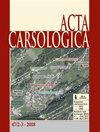Morphological characteristics and distribution of dolines in Slovenia, a study of a lidar-based doline map of Slovenia
IF 1.1
4区 地球科学
Q4 GEOSCIENCES, MULTIDISCIPLINARY
引用次数: 16
Abstract
Dolines are small to intermediate enclosed depressions and are the most numerous karst feature in Slovenia. They are circular in plan form and vary in diameter from a few metres to over a kilometre. They are developed in limestone, dolomite, carbonate breccia and conglomerate and occupy different geomorphic settings. They were formed by various processes like dissolution, collapse, suffosion and transformation of caves to surface features by denudation. Publicly accessible lidar data, provided by a nationwide laser scanning project of Slovenia, was used for this study. To catalogue the dolines, we manually label a fraction of the digital elevation model (DEM) with a binary mask indicating if the area is a doline or not. We then train a slightly modified u-net, a type of machine learning algorithm, on the labelled territory. Using the trained algorithm, we infer the binary mask on the entire DEM. We convert the resulting mask into an ESRI Shapefile and manually verify the results. We note that the training and inference are error prone on types of relief that were less common in the training set (e.g., the relatively uncommon collapse dolines). We believe manual verification mitigates most of these errors, so the resulting map is a good basis for the doline study. We have made our georeferenced catalogue of dolines available at https://dolines.org/ (Mihevc & Mihevc 2021). Dolines are found in most of the karst areas, except mountains where they were eroded by glacial action or covered by glacial deposits. We detected 471,192 dolines and divided them into three genetic types. Most abundant are solution dolines (470,325). The average doline is 9 m deep, has a diameter of 42 m and a volume of 14,098 m3. The density of dolines on levelled surfaces can be as high as 500/ per km2. They are absent from the floors of poljes and steeper slopes, and are less abundant on sloping surfaces. We have identified 314 dolines to be of collapse origin. The mean depth of collapse dolines is 49 m, and 20 of them are deeper than 100 m. The mean volume is 1.2 million m3, with the largest having a volume of 11.6 million m3. Most of the collapse dolines can be found close to ponors or springs or corridors where large underground rivers flow. We have detected 553 suffosion dolines formed by suffosion of sediments in blind valleys or on poljes. This basic data set for dolines enables further study and comparison of dolines with the geology and topography of the karst.斯洛文尼亚doline的形态特征和分布,斯洛文尼亚激光雷达doline地图的研究
多林是小型至中型封闭洼地,是斯洛文尼亚数量最多的喀斯特地貌。它们的平面形状是圆形的,直径从几米到一公里不等。它们在石灰岩、白云石、碳酸盐角砾岩和砾岩中发育,并占据不同的地貌环境。它们是由各种过程形成的,如溶解、坍塌、风化和洞穴通过剥蚀转变为地表特征。本研究使用了斯洛文尼亚全国激光扫描项目提供的可公开获取的激光雷达数据。为了对doline进行编目,我们用二进制掩码手动标记数字高程模型(DEM)的一部分,以指示该区域是否为doline。然后,我们在标记的区域上训练一个稍微修改过的u-net,一种机器学习算法。使用经过训练的算法,我们推断出整个DEM上的二进制掩码。我们将生成的遮罩转换为ESRI形状文件,并手动验证结果。我们注意到,在训练集中不太常见的起伏类型(例如,相对不常见的塌陷doline)上,训练和推断容易出错。我们相信手动验证可以缓解大部分错误,因此生成的地图是doline研究的良好基础。我们已在https://dolines.org/(Mihevc&Mihevc2021)。除了被冰川侵蚀或被冰川沉积物覆盖的山脉外,大多数喀斯特地区都有多林。我们检测到471192个doline,并将它们分为三种遗传类型。最丰富的是溶解doline(470325)。平均深度为9米,直径为42米,体积为14098立方米。平坦表面上的白云石密度可高达每平方公里500个。它们不存在于坡和陡坡的地面上,在斜坡上也不那么丰富。我们已经确定314个doline是坍塌成因。崩塌doline的平均深度为49 m,其中20条深度超过100 m。平均体积为120万m3,最大的一条体积为1160万m3。大多数坍塌的doline都可以在大型地下河流流动的池塘、泉水或走廊附近找到。我们已经探测到553个由盲谷或坡上沉积物的潜蚀作用形成的潜蚀白云石。这些白云石的基本数据集使人们能够进一步研究和比较白云石和岩溶的地质和地形。
本文章由计算机程序翻译,如有差异,请以英文原文为准。
求助全文
约1分钟内获得全文
求助全文
来源期刊

Acta Carsologica
地学-地球科学综合
CiteScore
1.50
自引率
14.30%
发文量
0
审稿时长
>12 weeks
期刊介绍:
Karst areas occupy 10-20 % of ice-free land. Dissolution of rock by natural waters has given rise to specific landscape and underground. Karst surface features and caves have attracted man''s curiosity since the dawn of humanity and have been a focus to scientific studies since more than half of millennia.
Acta Carsologica publishes original research papers and reviews, letters, essays and reports covering topics related to specific of karst areas. These comprise, but are not limited to karst geology, hydrology, and geomorphology, speleology, hydrogeology, biospeleology and history of karst science.
 求助内容:
求助内容: 应助结果提醒方式:
应助结果提醒方式:


